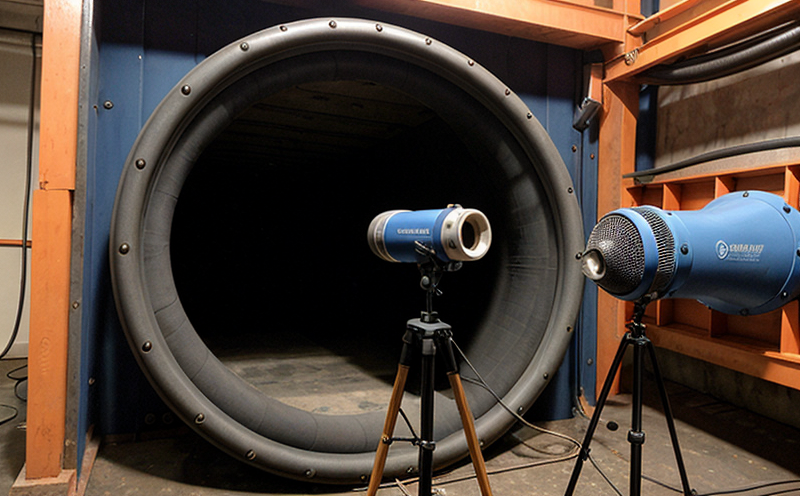ASTM E1065 Use of Digital Ultrasonic Instruments Testing
The ASTM E1065 standard provides a detailed procedure for using digital ultrasonic instruments to measure the thickness of metallic materials. This non-destructive testing (NDT) technique is widely used in industries such as aerospace, automotive, and manufacturing where material integrity is critical.
Ultrasonic testing is based on the principle that sound waves travel through a medium at a specific velocity. When these waves encounter an interface or defect within the material, they are reflected back to the sensor. By measuring the time it takes for the signal to return and analyzing its characteristics, technicians can determine the thickness of the material or identify flaws.
The ASTM E1065 standard specifies the use of digital ultrasonic instruments that provide precise measurements with high resolution. These instruments are designed to operate within a specific frequency range and pulse repetition rate, ensuring accurate results across various materials and applications.
Before conducting an ASTM E1065 test, it is crucial to prepare the specimen properly. This includes cleaning the surface of the material to remove any dirt or debris that could interfere with the ultrasound signal. The instrument must also be calibrated according to manufacturer guidelines to ensure accurate readings.
The testing process involves placing the ultrasonic probe on one side of the material and sending a pulsed sound wave through it. The reflected waves are then captured by the receiver and analyzed by the instrument. The results can be displayed as a waveform or in tabular form, providing detailed information about the thickness variations within the material.
ASTM E1065 provides specific guidelines for interpreting these results. Thickness measurements should fall within specified tolerances to meet industry standards. Any deviations from these tolerances may indicate potential issues with the material's integrity. Additionally, ASTM E1065 outlines procedures for handling and documenting any defects found during testing.
The use of digital ultrasonic instruments offers several advantages over traditional methods. These include higher accuracy, faster data acquisition, and easier post-processing of results. The digital format allows for real-time analysis and immediate feedback, which is particularly useful in high-throughput environments.
- Improved Accuracy: Digital instruments provide more precise measurements compared to analog counterparts.
- Faster Testing: Automated systems can process multiple readings quickly, reducing testing time significantly.
- Easier Documentation: Results are easily stored and retrieved for future reference or audits.
Applied Standards
The ASTM E1065 standard is widely recognized in industries that require precise thickness measurements of metallic materials. It is particularly relevant to sectors where material integrity and safety are paramount, such as aerospace, automotive, and manufacturing.
This standard ensures consistency and reliability across different testing environments by providing a standardized procedure for ultrasonic testing. Compliance with ASTM E1065 helps manufacturers meet regulatory requirements and maintain high-quality standards in their products.
Other relevant standards include ISO 9779, which provides guidelines for the use of ultrasonic thickness measurement instruments, and EN 45382, which specifies the calibration procedures for these devices. By adhering to these standards, laboratories can ensure that their testing practices are up-to-date with industry best practices.
The ASTM E1065 standard also emphasizes the importance of proper instrumentation and calibration. Digital ultrasonic instruments must be regularly calibrated according to manufacturer guidelines to maintain accuracy. This ensures that all measurements conform to international standards, enhancing trust in the results provided by the laboratory.
Eurolab Advantages
At Eurolab, we pride ourselves on providing top-tier ultrasonic testing services based on ASTM E1065. Our team of experts ensures that every test is conducted with precision and care, delivering reliable results that meet or exceed industry standards.
Our state-of-the-art equipment, calibrated regularly to the highest standards, guarantees accurate measurements and consistent results. With extensive experience in performing ultrasonic testing, our technicians are equipped to handle a wide range of materials and thicknesses.
We offer comprehensive services including pre-test consultations, detailed reports, and post-test analysis. Our commitment to quality is reflected in our ISO/IEC 17025 accreditation, which ensures that all our tests adhere to the highest scientific standards.
Choose Eurolab for your ultrasonic testing needs, and experience the difference in reliable, accurate results. Contact us today to discuss how we can assist you with ASTM E1065 testing services tailored to meet your specific requirements.
Why Choose This Test
- Precision: ASTM E1065 provides precise measurements that are essential for maintaining material integrity.
- Reliability: The standardized procedure ensures consistent results across different testing environments.
- Efficiency: Digital instruments allow for faster data acquisition and easier post-processing, saving time and resources.
- Compliance: Adherence to ASTM E1065 helps manufacturers meet regulatory requirements and maintain high-quality standards in their products.





